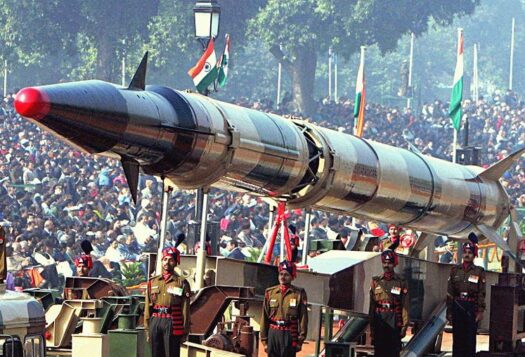
Ever since South Asia became a nuclear weapons zone, efforts have been needed to reduce the possibility of a nuclear exchange between India and Pakistan. Short of nuclear disarmament, ensuring strategic stability in the region is the only way this danger can be nullified. India’s no first use (NFU) doctrine has kept the nuclear threshold high in South Asia. On the other hand, Pakistan’s first-use option, coupled with the introduction of tactical nuclear weapons (TNWs), has lowered the threshold considerably. Until nuclear disarmament becomes accepted worldwide, a bilateral NFU treaty could be an effective way to bolster strategic stability in the region.
Pakistan’s defense minister, Khawaja Asif, affirmed in July 2015 that Pakistan would use nuclear weapons for its survival should the need arise. TNWs, such as the 60-km range Nasr, suggest that Islamabad considers warfighting, not solely deterrence, as an appropriate use of nuclear weapons
However, for India, nuclear weapons are meant to strengthen deterrence and prevent conflict. New Delhi’s doctrine holds that nuclear weapons can only deter a nuclear war. Many Indian analysts are of the belief that limited conventional conflict under the nuclear umbrella remains possible. India has also refrained from developing TNWs, and argued that any kind of nuclear weapon use will prompt massive retaliation, as stated in the country’s nuclear doctrine.
In South Asia, the threat of nuclear first use is strategically destabilizing because it lowers the nuclear threshold. Pakistan’s TNWs, coupled with a first-use option, further complicate command-and-control issues, since a handful of weapons are expected to be under control of battlefield commanders in times of conflict.
A bilateral NFU treaty between Pakistan and India would make TNWs less relevant, maintain deterrence, and reduce the chances for miscalculation in a crisis. India would also need to pledge to never develop TNWs, in order to make the treaty a win-win for both. While it could be difficult to define TNWs, both the countries could refrain from developing nuclear-capable ballistic and cruise missiles up to 500 km. Currently, India possesses the Agni-I and Pakistan has the Shaheen-1A short range ballistic missile (SRBM), which in South Asia are not SRBMs but missiles able to reach strategic targets, strengthening the principle of mutually assured destruction (MAD). Moreover, as India’s response to any nuclear attack from adversaries is supposed to be massive retaliation, it would not make sense for Pakistan to attack India with TNWs and invite a response so cataclysmic. Pledging to refrain from nuclearizing their artillery systems will also ensure strategic stability and keep the nuclear threshold high in South Asia.
A bilateral NFU agreement already exists between Russia and China. China has a universal NFU policy. Russia gave up its commitment to NFU after the collapse of the Soviet Union, but continues the commitment with China.
Similarly, for any nuclear confidence building measure (CBM) to be undertaken between Pakistan and India, it is crucial for India to comprehend the former’s threat perceptions. While India is a perceived threat, some accounts suggest that Israel was planning an attack on Pakistan’s nuclear facility in Kahuta in the 1980s. Therefore, Pakistan may be wary of Israel’s capability to destroy its nuclear facilities—Pakistan’s 2,750 km (around 1,700 miles) range Shaheen-III missile has the potential of reaching far in the Middle East.
Similarly, Pakistan fears possible sabotage of its nuclear weapons facilities by the United States, an apprehension that has existed since 1979 when Islamabad had concerns over a U.S. attack on Kahuta. These fears were reinforced after Osama bin Laden’s killing in 2011.
Achieving a bilateral NFU treaty is possible if both India and Pakistan are able to address each other’s concerns. Strong CBMs already exist—both countries have declared voluntary moratoria on nuclear testing, exchange information on nuclear installations each year, and notify each other before conducting ballistic missile tests. Moreover, as Pakistan’s nuclear weapons are reported to be in a de-mated and de-alerted posture, an NFU treaty with India would only enable Pakistan to strengthen this posture and prevent nuclear theft or irrational launch.
Both India and Pakistan could further their own national interests by adopting a bilateral NFU treaty. NFU is already stated in India’s doctrine. It would be conducive for Pakistan too, since it will enable them to reshape the international narrative about their nuclear program, while maintaining a robust strategic deterrent. As both countries move ahead with developing second-strike capabilities, adopting such an NFU could be ideal. Nuclear arms control between India and Pakistan could then become a reality.
***
Image: Anadolu Agency, Getty


